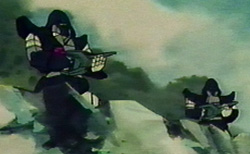

Designation:QPR-19 Golem GMP-Enforcement Corps Autonomous Police Robot
|

|
||||

|
|||||
| Total Height: | 4.9m |
| Total Depth: | 1.3m |
| Total Breadth: | 2.3m |
| Weight: | 7.3 metric tons |

Common optional pods for used by the hands:
|
The armor on the Golem/Bobby is a new development in low-mass composite-materials Chobham plating that became the standard for all Terran mecha after its application to the VQ-6A Vandal. Aside from the respectable protection provided against projectiles, missiles, and other kinetic weapons, this armor is also resistant to plasma globes (annihilation discs), lasers, and to a lesser extent, particle guns, owing to the fact that the armor can flake off and evaporate in layers under fire from such high-energy weapons, taking much of the weapon's energy and converting it into the latent heat of sublimation in the armor. The armor stops all small arms and heavy infantry weapons fire, provides excellent resistance to light mecha-mounted weaponry, such as the Zentraedi 22.3mm HE autocannon round, and fair resistance to medium mecha-mounted weaponry, such as the Valkyrie's 55mm APFSDS round.
The SPA-19 Bobby provides full protection from nuclear, biological, and chemical hazards, using an over-pressure cockpit module activated by radiation and hazardous chemical sensors, or manually when biological warfare conditions are anticipated. The NBC filtration system can provide atmosphere purification for one week maximum before filters must be replaced.
Vickers developed the SPR-19 power armor for the Global Military Police to augment the field presence of its troops. Though never meant to go toe-to-toe with full-sized Zentraedi soldiers (that was the job of the Tactical Corps and the Civil Defense Unit), it did give the GMP the flexibility to handle many situations that it could not deal with on itís own before. The SPR-19, nicknamed the Bobby by the British department of the GMP, could act as a riot control unit along with dismounted police. It was helpful in dealing with bomb threats and explosive ordinance disposal. The bobby was also a more effective patrol vehicle and siege breaker than the more traditional armored cars, such as the M-11, used by military police in the past.
In a pinch, this unit provided a suit where the GMP trooper could keep up with a full-sized Zentraedi at a run, as well as providing a platform that could mount large enough weapons to subdue them without sacrificing combat agility. The Bobby allowed the GMP to operate with out being dependent on the other services for heavy support. Also, when using this system, the GMP could keep a much lower profile than would be otherwise possible with a platoon of Salamanders or Unicorns.
As useful and flexible as the SPR-19 was, not many of these suits were produced. The GMP sites cost as the prohibiting factor, but that line of reasoning directly conflicts with their decision to develop and produce (in larger numbers no less) the QPR-19 Golem.
The SCAR had a pet project at the time. Flush with an over generous research grant, they experimented with artificial intelligence to provide the perfect GMP soldier: one that would follow orders without question, would objectively enforce the law, and work overtime with out time-and-a-half pay. More importantly, it could not be turned against the authority of its higher command: the UEG. Working from research conducted on the SDF-1's E.V.E. computer before itís destruction at the end of the 1st Robotech War, they attempted to develop an unmanned Battloid that could be used for police operations. To reduce costs and expedite development, they decided to utilize the existing GMP SPA-19 power armor as the main body of the robot. The GMP researchers opted against the more limited, animalistic, intelligence capabilities later chosen by the REF for its ASAVAN "Shadow Drone" (they needed more than a giant sized German Shepard), and instead developed a robot that was nearly as intelligent as a human and fully possessed of reflexive consciousness. However, the trade off was that the end product turned out to be far too slow and ponderous for effective combat duties.
Simply too much processing power was packed into too small a package, and the Golem came off as both dim and pedantic, capable of quoting regulations and identifying violators, but only barely capable of independent action in police duties. The robot needed explicit instructions and a number of incidents were caused by omissions of detail in commands. A good analogy would be to compare it to the Deep Blue chess computer of the late twentieth century. It was possessed of a high degree of analytical judgment, but the time that it took to come to a final decision could be measured in seconds: fare to long in a combat situation. As such, the GMP paired the robots in the field with an operator, often times in a Bobby, who would able to provide guidance to the AI, yet still be able to take advantage of the increased capabilities of the battloid. Predictably, many of their operators became fondly attached to their Golems due to their human like intelligence and the individual personalities that each unit developed over time. The connection was not unlike that between a K9 handler and his dog.
The Golems were also frequently assigned to guard duties that involved little interaction or extremely high security installations where high command would want to minimize exposing lower enlisted soldiers to classified information and could accept any violation of protocol resulting in someone being shot. Due to its small size, the Golem could not effectively wield the larger gun pods developed for other SC battloids. Instead it uses the smaller EU-17 particle beam cannon. The GMP Police Robot, the Golem, was introduced in 2023 and was used extensively in the later parts of the Second Robotech War as the high command became more and more desperate. The Golems were viewed as expendable troops and were pressed into duty to support units in the field. They frequently were given the worst tasks in the field and as such suffered a high mortality rate due to their slow reaction times. Limited numbers of Golems were also acquired by the Tactical Corps for mine clearing operations and other combat engineering duties.
The Golems suffered severe attrition in that war and in the following Invid invasion, so that very few remain.
Go to Southern Cross Battloid Gallery.
See additional design notes.
Return to Southern Cross Mecha Index.
Go to Robotech Reference Guide Home Page.
Robotech (R) is the property of Harmony Gold. This document is in no way intended to infringe upon their rights.
Content by Rob Morgenstern, Tim Wing and Peter Walker, with Pieter Thomassen